Microsoft’s deep understanding of human-operated ransomware attacks, which are powered by a thriving cybercrime gig economy, continuously informs the solutions we deliver to protect customers. Our expert monitoring of threat actors, investigations into real-world ransomware attacks, and the intelligence we gather from the trillions of signals that the Microsoft cloud processes every day provide a unique insight into these threats. For example, we track human-operated ransomware attacks not only as distinct ransomware payloads, but more importantly, as a series of malicious activities that culminate in the deployment of ransomware. Detecting and stopping ransomware attacks as early as possible is critical for limiting the impact of these attacks on target organizations, including business interruption and extortion.
To disrupt human-operated ransomware attacks as early as possible, we enhanced the AI-based protections in Microsoft Defender for Endpoint with a range of specialized machine learning techniques that find and swiftly incriminate – that is, determine malicious intent with high confidence – malicious files, processes, or behavior observed during active attacks.
The early incrimination of entities – files, user accounts, and devices – represents a sophisticated mitigation approach that requires an examination of both the attack context as well as related events on either the targeted device or within the organization. Defender for Endpoint combines three tiers of AI-informed inputs, each of which generates a risk score, to determine whether an entity is associated with an active ransomware attack:
- A time-series and statistical analysis of alerts to look for anomalies at the organization level
- Graph-based aggregation of suspicious events across devices within the organization to identify malicious activity across a set of devices
- Device-level monitoring to identify suspicious activity with high confidence
Aggregating intelligence from these sources enables Defender for Endpoint to draw connections between different entities across devices within the same network. This correlation facilitates the detection of threats that might otherwise go unnoticed. When there’s enough confidence that a sophisticated attack is taking place on a single device, the related processes and files are immediately blocked and remediated to disrupt the attack.
Disrupting attacks in their early stages is critical for all sophisticated attacks but especially human-operated ransomware, where human threat actors seek to gain privileged access to an organization’s network, move laterally, and deploy the ransomware payload on as many devices in the network as possible. For example, with its enhanced AI-driven detection capabilities, Defender for Endpoint managed to detect and incriminate a ransomware attack early in its encryption stage, when the attackers had encrypted files on fewer than four percent (4%) of the organization’s devices, demonstrating improved ability to disrupt an attack and protect the remaining devices in the organization. This instance illustrates the importance of the rapid incrimination of suspicious entities and the prompt disruption of a human-operated ransomware attack.
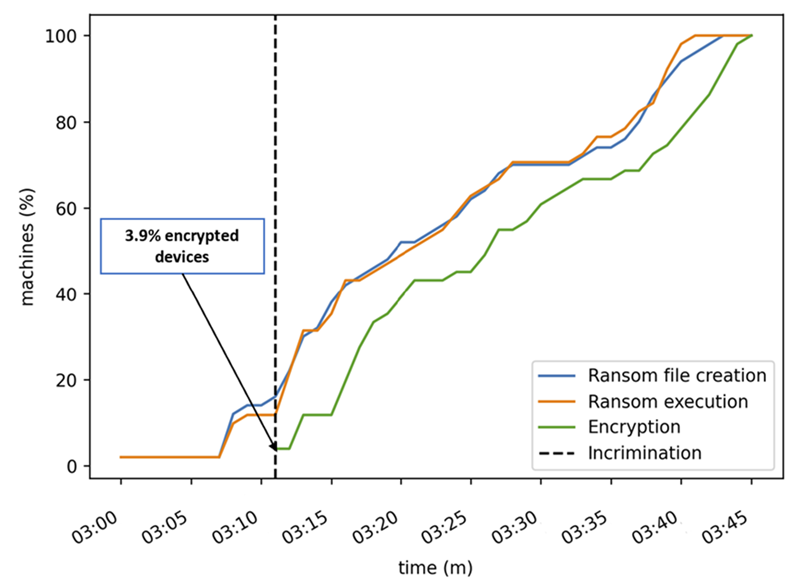
As this incident shows, the swift incrimination of suspicious files and processes mitigates the impact of ransomware attacks within an organization. After incriminating an entity, Microsoft Defender for Endpoint stops the attack via feedback-loop blocking, which uses Microsoft Defender Antivirus to block the threat on endpoints in the organization. Defender for Endpoint then uses the threat intelligence gathered during the ransomware attack to protect other organizations.
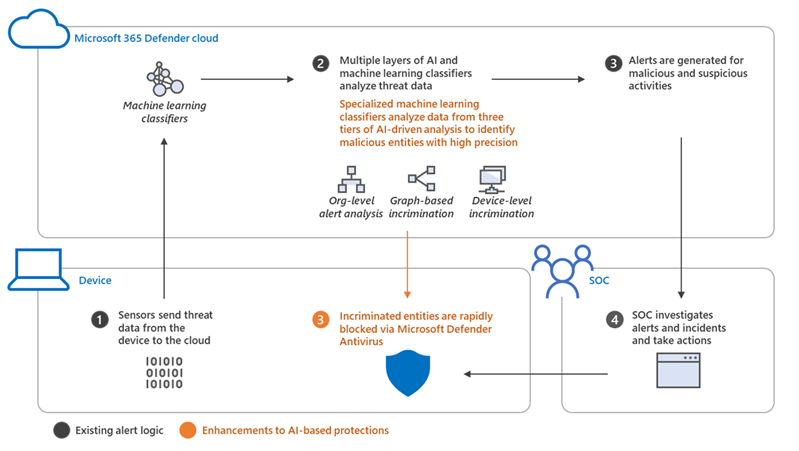
In this blog, we discuss in detail how Microsoft Defender for Endpoint uses multiple innovative, AI-based protections to examine alerts at the organization level, events across devices, and suspicious activity on specific devices to create a unique aggregation of signals that can identify a human-operated ransomware attack.
Detecting anomalies in alerts at the organization level
A human-operated ransomware attack generates a lot of noise in the system. During this phase, solutions like Defender for Endpoint raise many alerts upon detecting multiple malicious artifacts and behavior on many devices, resulting in an alert spike. Figure 3 shows an attack that occurred across a single organization.
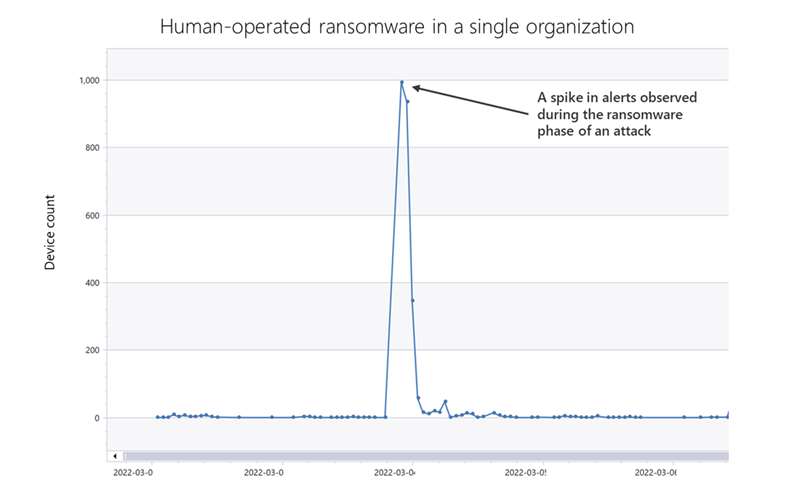
Defender for Endpoint identifies an organization-level attack by using time-series analysis to monitor the aggregation of alerts and statistical analysis to detect any significant increase in alert volume. In the event of an alert spike, Defender for Endpoint analyzes the related alerts and uses a specialized machine learning model to distinguish between true ransomware attacks and spurious spikes of alerts.
If the alerts involve activity characteristic of a ransomware attack, Defender for Endpoint searches for suspicious entities to incriminate based on attack relevance and spread across the organization. Figure 4 shows organization-level detection.

Graph-based monitoring of connections between devices
Organization-level monitoring can pose challenges when attacks don’t produce enough noise at the organization level. Aside from monitoring anomalous alert counts, Defender for Endpoint also adopts a graph-based approach for a more focused view of several connected devices to produce high-confidence detections, including an overall risk score. For this level of monitoring, Defender for Endpoint examines remote activity on a device to generate a connected graph. This activity can originate from popular admin tools such as PsExec / wmi / WinRm when another device in the organization connects to a device using admin credentials. This remote connection can also indicate previous credential theft by an attacker.
As administrators often use such connectivity tools for legitimate purposes, Defender for Endpoint differentiates suspicious activity from the noise by searching specifically for suspicious processes executed during the connection timeframe.
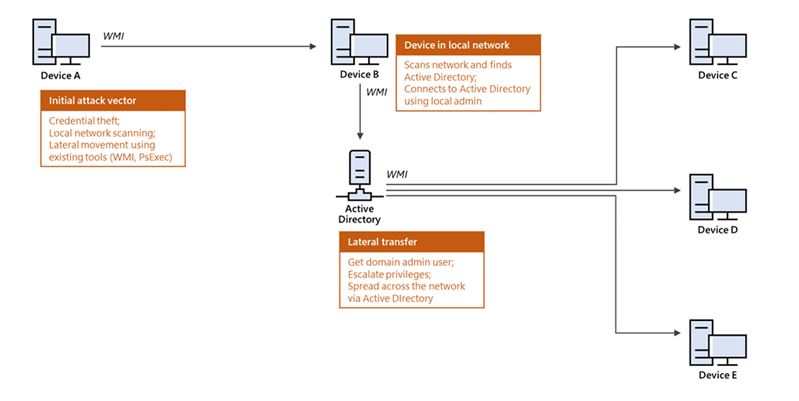
Figure 5 shows a typical attack pattern wherein a compromised device A is the initial attack vector, and the attacker uses remote desktop protocol (RDP) or a remote shell to take over the device and start scanning the network. If possible, the attackers move laterally to device B. At this point, the remote processes wmic.exe on the command line and wmiprvse.exe on the target can spawn a new process to perform remote activities.
Graph-based detection generates the entities in memory to produce a virtual graph of connected components to calculate a total risk score, wherein each component represents a device with suspicious activities. These activities might produce low-fidelity signals, such as scores from certain machine learning models or other suspicious signals on the device. The edges of the graph show suspicious network connections. Defender for Endpoint then analyzes this graph to produce a final risk score. Figure 6 highlights an example of graph-based aggregation activities and risk score generation.
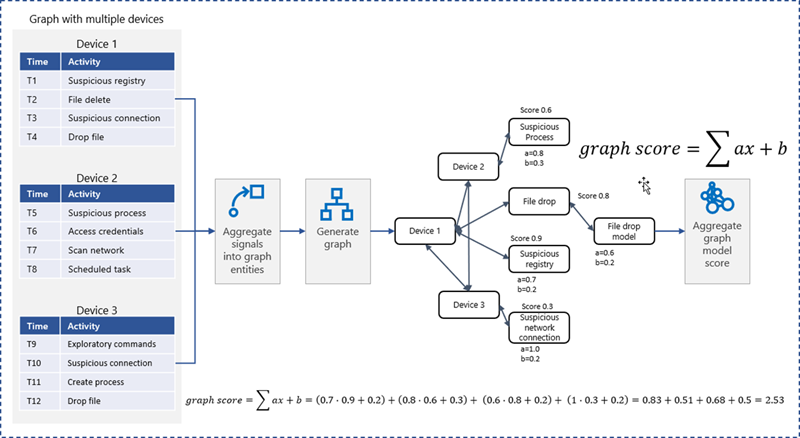
Identifying suspicious activity with high confidence on a single device
The final detection category is identifying suspicious activity on a single device. Sometimes, suspicious signals from only one device represent enough evidence to identify a ransomware attack, such as when an attack uses evasion techniques like spreading activity over a period of time and across processes unrelated to the attack chain. As a result, such an attack can fly under the radar, if defenses fail to recognize these processes as related. If the signals are not strong enough for each process chain, no alerts will generate.
Figure 7 depicts a simplified version of evasion activity using the Startup folder and autostart extension points. After taking over a device, an attacker opens cmd.exe and writes a file to the Startup folder to carry out malicious activities. When the device restarts, the file in the Startup folder performs additional commands using the parent process ID explorer.exe, which is unrelated to the original cmd.exe that wrote the file. This behavior splits the activity into two separate process chains occurring at different times, which could prevent security solutions from correlating these commands. As a result, when neither individual process produces enough noise, an alert might not appear.
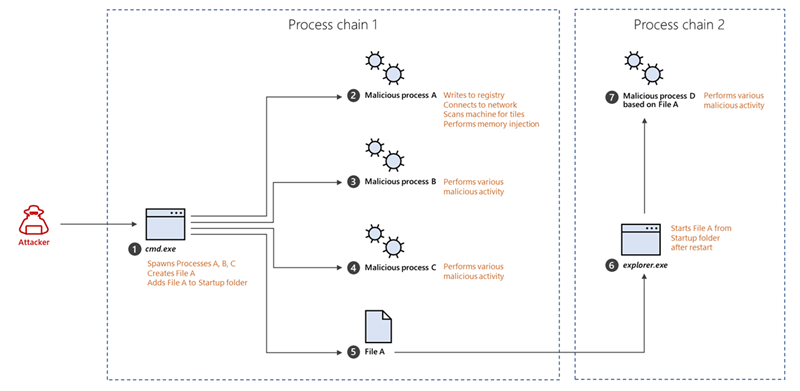
The enhanced AI-based detections in Defender for Endpoint can help connect seemingly unrelated activity by assessing logs for processes that resemble DLL hijacking, autostart entries in the registry, creation of files in startup folder, and similar suspicious changes. The incrimination logic then maps out the initiation of the first process in relation to the files and tasks that follow.
Human-operated ransomware protection using AI
Attackers behind human-operated campaigns make decisions depending on what they discover in environments they compromise. The human aspect of these attacks results in varied attack patterns that evolve based on unique opportunities that attackers find for privilege escalation and lateral movement. AI and machine learning present innovative methods for surfacing sophisticated attacks known for using advanced tools and techniques to stay persistent and evasive.
In this blog, we discussed enhancements to cloud-based AI-driven protections in Microsoft Defender for Endpoint that are especially designed to help disrupt human-operated ransomware attacks. These enhanced protections use AI to analyze threat data from multiple levels of advanced monitoring and correlate malicious activities to incriminate entities and stop attacks in their tracks. Today, these AI protections are triggered in the early stages of the ransomware phase, as the attack starts to encrypt data on devices. We’re now working to expand these protections to trigger even earlier in the attack chain, before the ransomware deployment, and to expand the scope to incriminate and isolate compromised user accounts and devices to further limit the damage of attacks.
This innovative approach to detection adds to existing protections that Microsoft 365 Defender delivers against ransomware. This evolving attack disruption capability exemplifies Microsoft’s commitment to harness the power of AI to explore novel ways of detecting threats and improve organizations’ defenses against an increasingly complex threat landscape.
Learn how Microsoft helps you defend against ransomware.
Learn how machine learning and AI drives innovation at Microsoft security research.
Arie Agranonik, Charles-Edouard Bettan, Sriram Iyer, Amir Rubin, Yair Tsarfaty
Microsoft 365 Defender Research Team








